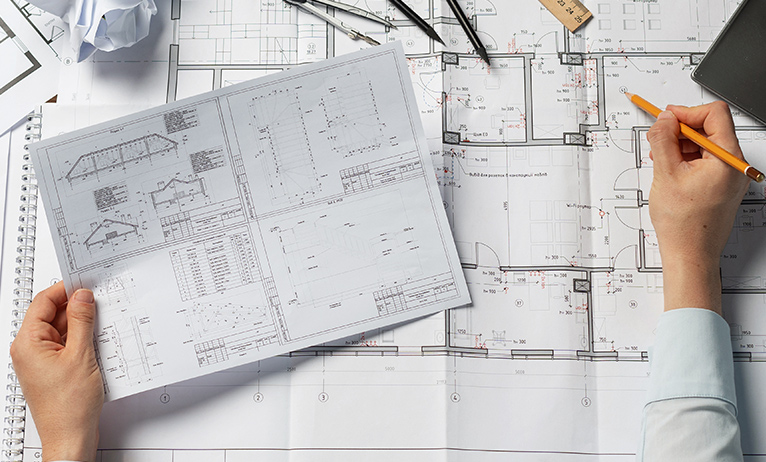What planning permission do I need?

Applying for planning permission for building works can seem like a daunting task, especially if you’ve never done renovations to your home before, and don’t know what the relevant rules and regulations are.
But it doesn’t have to be. In fact, a building project should be an exciting prospect. This guide covers everything you need to know about planning permission, so that you can ensure your building works are completed smoothly and following all the correct requirements.
If you’re ever in doubt, we advise that you contact your local planning authority to discuss your planning proposal before you begin works.
What is planning permission?
Planning permission is the approval you need to get to carry out building works, including demolitions and expansions. It’s usually required when homeowners want to build something new, make a major change to their home, or change the use of their building.
Most planning applications for a proposed development are submitted online, through the Planning Portal website. Through this portal, you can apply to every single local planning authority in England. Keep in mind that planning permission requirements vary in Scotland, Wales, and Northern Ireland.
Some planning applications will cost a planning fee, which you can calculate using this fee calculator. There is an additional £26.83 service charge for applications that cost more than £60.
If you don’t want to apply for it yourself, your architect, builder, or solicitor can do it for you, as long as all the owners or leaseholders are told about the application beforehand.
The Planning Portal website highly encourages that you contact a planning officer before applying for planning permission. They will be able to advise you on the type of consent you need, and whether there are any local constraints in your area that could affect your application.
For more information about the legislation involved in applications for planning permission, read the Town and Country Planning Act 1990.
To avoid an invalid application, it’s important that you apply for the right type of planning permission. You’re most likely to need householder planning application:
Householder planning consent
Householder planning consent is the most common planning permission used by homeowners who want to complete work on their home. Not including flats, it’s used to process applications to alter or enlarge single homes, and includes all building works that fall within the boundaries of your home and garden.
Some of the most common householder planning permission applications include:
- Extensions
- Conservatories
- Loft conversions
- Dormer windows
- Garages
- Outbuildings
- Swimming pools
- Walls and fences
- Porches
- Satellite dishes
You will often need to submit some documents with your application. Most commonly, these include a site plan and a location plan, but what you’ll need will vary depending on your project.
Sometimes, you might also be charged a Community Infrastructure Levy. For instance, if you were building a conservatory, adding over 100 square metres of floor space would make your project liable to an infrastructure levy charge.
You can expect decisions on your householder planning application to take up to eight weeks.
A standard householder application for work on a single house costs £206.
A householder application won’t always be the right fit, especially if your project is for:
- A new building or commercial project
- A flat
- To do with major structural alterations
- Demolitions
- Applications to change the number of dwellings
In these cases, you’re more likely to need full planning consent.
If you want to get a better understanding of whether or not your development project will be lawful, in terms of its scale and nature, then you might want to apply for outline consent.
You can apply for all of these through the online Planning Portal system. A few types of applications, including hybrid applications, cannot be applied for online.
You will receive a letter informing you of whether your application was granted or refused.
By law, your planning permission will expire after a certain amount of time. In general, you usually have three years from the date your permission was granted to start the development. If by then you haven’t started building works, you will probably need to reapply for planning permission.
Once you’ve gotten your planning permission, you’ll be able to start building works. You can hire skilled labour to help you complete your project here.
Close section ↑
What are permitted development rights?
Not all building works require planning permission. Those that don’t fall under permitted development rights (PDs) and can be completed without needing to make an application.
PDs mostly cover houses, and don’t usually apply to flats, maisonettes, and other buildings. As well as this, in certain ‘designated areas’ there are more restrictions on PDs. For example, if you live in a:
- Conservation Area
- National Park
- Area of Outstanding Natural Beauty
- World Heritage Site
- Norfolk or Suffolk Broads
Often, you will also be exempt from permitted development rights if you live in a listed building.
Whether or not you will need a planning application is determined by your specific project and its scope. The Planning Portal website covers all major building works and includes lists of criteria that explain what rules you need to follow to avoid a planning application.
For example, extensions are considered permitted development. One of the limitations for building an extension under permitted development rights is that the extension cannot cover more than half the area of land around the original property. If you were to want an extension that would cover more than half the area of the land around your property, you would need to apply for planning permission.
Close section ↑
What is allowed under permitted development?
Some current home improvement projects that don’t require planning permission (as long as you build within your permitted development rights) include:
- Additional storeys/extending upwards
- Converting an existing cellar or basement into a living space
- Installing a boiler or other heating systems (if all the work is internal)
- To replace a ceiling or floor (unless you live in a listed building, in which case we recommend checking with your local planning authority first)
- Putting up decking or another raised platform in your garden
- Repairing, repainting or doing minor improvements to door frames and windows, inserting a new window or door (of a similar appearance to those used in the construction of the house), or installing internal secondary glazing
- Repairs, maintenance and minor work done to drains and sewers
- Installing or replacing electrical circuits
- Adding a house extension or conservatory
- Repairs, maintenance and minor improvements to external walls, including cladding
- Maintenance, painting, or replacement of fascia (unless you live in a listed building, in which case we recommend checking with your local planning authority first)
- Erecting, altering, maintaining, improving, or taking down an existing fence, wall, or gate
- Fitting, altering, or replacing an external flue, chimney, or soil and vent pipe
- Garage conversions, (provided the work is internal and doesn’t involve enlarging your home). However, sometimes permitted development rights for garage conversions don’t apply certain properties.
- Installing a ground source or water source heat pump, unless you live in a listed building or conservation area
- Fitting insulation (where there is no change to the external appearance of your home)
- Changes to internal walls (unless you live in a listed building, in which case we recommend checking with your local planning authority first)
- Installing a new kitchen or bathroom (unless it’s part of a house extension, or your home is a listed property)
- Loft conversions
- Paving your front garden with a new or replacement driveway of any size using permeable or porous surfacing that allows water to drain
- Adding a porch
- Alterations to your roof
If your project does not conform to the specific limitations and conditions that allow it to be a permitted development project, then you will most likely need to apply for planning permission. You can check what the requirements are here.
We recommend you speak to your local planning authority before starting building works, regardless of whether your project requires planning permission or not.
Close section ↑
What is planning prior approval?
For some building works, one of the things that enable a project to fall under permitted development rights is that prior approval is required. Prior approval is an application that allows your local authority to check your proposal and consider its impact on your local area.
Prior approval is often required for:
- Home extensions
- Creating dwellings
- Change of use to dwellings
- New dwellings
- Electronic communications networks
- Demolition
- Agriculture and forestry
- Developments on non-residential buildings
- Some other change of use and temporary use applications
The standard fee for prior approval applications is £96.
You must not start building works until your prior approval is approved by your local planning authority. This shouldn’t take longer than eight weeks.
Close section ↑
What are building regulations?
Building regulations cover construction and extension works, and deal with the technical details of your building project, with the aim of ensuring health and safety regulations are met.
Building regulations are different to planning permission, which focus more on the appearance and effect of your project on your neighbourhood.
Your project might require that you apply for both planning permission and building control. If it does, you will need to make two separate applications. You can apply for building regulations here.
Close section ↑
Retrospective planning permission
If you don’t get the right approval before building works begin, and you start works for a project that does require planning permission, your local authority can ask you (or the owner of the property) to submit retrospective planning permission, for the work that you’ve already carried out.
Keep in mind that just because your local authority has requested retrospective planning permission, it doesn’t mean that your application will be accepted. Failure to comply with planning permission is called a planning breach. If you’re in this position, don’t worry, this isn’t illegal. Your local council will usually grant a retrospective application.
However, if your application is refused, you may be issued an enforcement notice. Enforcement action means that you’ll have to undo any works that you started and turn your home back to how it was before you began your project. This usually happens when the breach involves a previously rejected application.
The other common reason why your retrospective application might fail is if your project involves work that could or has been harmful to you or members of your neighbourhood.
Close section ↑
Making an appeal
You can make a planning appeal on your application if you disagree with a decision made by your local authority, or if it’s been over eight weeks and a decision hasn’t been made yet.
Planning appeals are dealt with by the Planning Inspectorate, which is independent from the local planning authority (LPA). Whoever is dealing with your application will consider material planning considerations from all parties, including yourself and the LPA.
Alternatively, your local authority might grant you permission, but only subject to certain conditions. These will usually be to do with specific details that will need to be confirmed before you can start building works (for example, approval of materials), or even certain restrictions on your project that you will need to implement to get full permission.
Close section ↑
Conclusions

Making sure you have all the right permissions is really important, especially if you want to avoid the potential risk of an enforcement notice. The best thing you can do is get pre-application advice by speaking to someone at the planning department of your local planning authority. They will be able to advise you on your application and the relevant paperwork you will need.
If you’re unsure of the order you need to apply for things, we recommend you consult this Planning Portals guide, which outlines the process clearly.
If you’re thinking of starting a new home improvement project, we recommend looking into and applying for permissions as soon as possible, as it can take up to eight weeks for your local planning authority to grant it.
Once you get the right permissions, you will be able to start your project. You can hire skilled tradespeople on our website to help you complete your building works.



